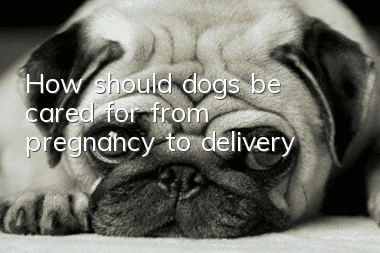How should dogs be cared for from pregnancy to delivery?

1. What does a dog look like when she is pregnant? How to judge? Pregnant female dogs usually have a quiet temperament, move cautiously, gradually increase their food intake, are not active, and like to lie quietly and rest in a warm place, and their coat becomes luster. A few female dogs will have a period of pregnancy reactions, vomiting, loss of appetite, and some even have a partial eclipse around 25 days into pregnancy. During pregnancy, the breasts become enlarged, elastic, and droopy, and the nipple color changes to light red. In the morning on an empty stomach, gently touch your abdomen with your hands. You can feel elastic meat balls about the size of eggs, but you should pay attention to the difference between them and inelastic fecal balls. Do not use too much force when touching to avoid hurting the fetus. Female dogs can also have false pregnancies. The main symptoms of pseudopregnancy are: gradual accumulation of abdominal fat, abdominal enlargement, nervousness causing breast development, abnormal breathing, and nesting behavior between 60 and 70 days. In severe cases, it manifests as maternal instinct, such as refusing to eat, protecting inactive objects (such as slippers, toys, rag dolls, etc.) as one's own puppies, allowing the puppies to suck milk, and lactation lasts for several weeks, but colostrum cannot be formed. Dog bites caused by false pregnancies can affect the production of a litter. False pregnancy is caused by endocrine disorders, and pregnancy will occur repeatedly, causing metritis. Therefore, bitches who often have false pregnancy should not give birth to puppies
2. How to take care of a pregnant dog? Compared with other animals, abortion in dogs is very rare. But pregnant female dogs also need special care. In terms of diet, food rich in protein, vitamins, minerals and other nutrients should be given. Pregnant female dogs have a sharp increase in calcium needs, so special attention should be paid to supplements. The female dog's nest should be regularly ventilated, kept clean and dry, to prevent drought in winter and heatstroke in summer. The female dog during pregnancy is relatively lazy and cannot be allowed to be free, otherwise the fetus will be too large and it will easily cause dystocia. It should be forced to exercise, which can accumulate strength for the birth, but excessive and excessive exercise should be avoided. Precautions for dogs during pregnancy: 1. The nutritional content is higher than usual, so eat small and frequent meals; 2. Do not hug the dog’s belly hard; 3. Do not give medicine to the dog casually; 4. Do not exercise strenuously.
3. Issues that should be paid attention to during childbirth. Dogs are multi-fetal animals, so the pain during childbirth requires dogs to have greater tolerance. With the arrival of labor pains, the real childbirth process will begin. After all the fetuses were successfully delivered, the female dog began to become quiet and content. A very small number of female dogs also eat their cubs, so more attention should be paid. When necessary, the female dog will undergo midwifery. Before midwifery, washbasins, towels, gauze, scissors, tweezers and other tools should be prepared to ensure the safety of the birth. After the delivery begins, the fetus should be slowly pulled out. If the fetal position is incorrect, causing dystocia, the fetus can be pushed back into the uterus to correct the fetal position and ensure smooth delivery. When the female dog is giving birth, she should avoid strangers visiting her, let alone touching her puppies, because the female dog is extremely sensitive at this time and is prone to impulsive attacks on outsiders and onlookers. Postpartum female dogs are lazy to drink and eat, so be careful to feed them nutritious food.
4. Nursing care of mother dog
(1) Within 2-3 days after giving birth, the dog mother should feed one-third of the amount of food during pregnancy. The food can be less but more refined (the dog mother’s appetite will not be too good). It can be gradually increased after 4 days and returned to the original state in 10 days. food intake.
(2) During the breastfeeding period, the dog mother should pay attention to the food being rich in nutrients to meet the needs of lactation. The mother dog should be fed 3-4 meals a day. If the milk is insufficient, brown sugar water or milk can be added to the food. Feeding some broth on a regular basis is also very effective.
(3) During this period, the mother dog should also be groomed and cleaned, and should be bathed once a week.
(4) When the weather is warm, take the mother dog outside for a walk at least twice a day. Half an hour each time, and can be extended accordingly in the future. But you can't do strenuous exercise.
(5) Pay attention to the hygiene of the delivery room, clean it every day, replace the bedding in time, and disinfect the delivery room once a month.
(6) Finally, pay attention to keeping the delivery room and the surrounding environment quiet. Avoid loud sounds, noise, bright light and other strong stimulation, so that both mother and baby can have a good rest
- Reasons why dogs hiccup and vomit
- Symptoms and prevention of roundworms in dogs
- Should dogs drink cold water or warm water in winter?
- If your dog exhibits any of these abnormal behaviors, beware of arthritis!
- Canine distemper causes
- How to raise a dog to be particularly loyal? Dog training tips!
- How to solve the problem of dogs causing destruction at home? The method is very important!
- Common Dog Diseases and Prevention
- How often should dogs be dewormed?
- How to tell if a dog is blind



